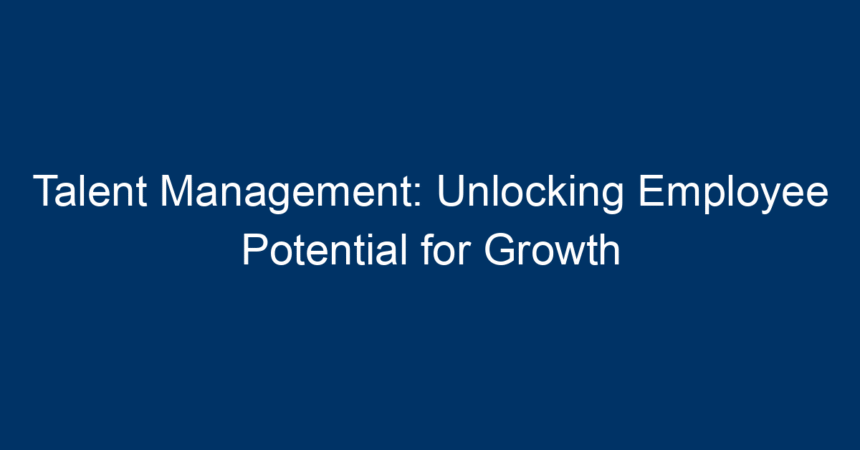In today’s competitive business landscape, companies are increasingly recognizing the pivotal role that talent management plays in driving organizational success. The concept transcends the mere hiring of personnel; it encompasses a holistic strategy for nurturing employee potential, fostering engagement, and ensuring sustainable growth. By effectively managing talent, organizations not only enhance productivity but also create a vibrant workplace culture that attracts and retains the best talent.
Understanding Talent Management
At its core, talent management refers to the systematic attractions, development, engagement, and retention of skilled individuals within an organization. It’s about aligning employees’ career aspirations with the goals of the organization to cultivate a work environment where both parties thrive.
Key Components of Talent Management
-
Attraction
The journey of talent management begins with attracting the right individuals. This involves crafting a strong employer brand and utilizing various recruitment strategies to bring in candidates who not only possess the required skills but also align with the organizational culture. -
Development
Once talent is onboard, continuous development becomes essential. This includes offering opportunities for skill enhancement through training, mentorship programs, and career progression pathways. When employees see a clear route for advancement, they are more engaged and motivated. -
Engagement
Employee engagement is a crucial aspect of talent management. Engaged employees are more productive, less likely to leave, and contribute to a positive workplace atmosphere. To foster engagement, organizations must communicate transparently, recognize achievements, and provide a supportive environment. - Retention
Retaining top talent is often more challenging than attracting it. Using tailored compensation packages, benefits, career development opportunities, and work-life balance strategies can significantly reduce turnover rates and keep valuable employees in place.
The Business Case for Talent Management
Effective talent management is not just beneficial to employees; it is also critical for the organization itself. When companies invest in their workforce, the return on investment can be substantial.
Enhanced Productivity
Organizations that actively focus on talent management experience boosted productivity levels. Engaged employees tend to work with more enthusiasm, are innovative, and contribute significantly to overall performance. This results in a more efficient work process and ultimately leads to higher profitability.
Reduced Recruitment Costs
Retention is a cornerstone of successful talent management. When employees are happy and engaged, the costs associated with recruitment and onboarding drastically diminish. The corporate mantra is clear: it’s cheaper to retain existing talent than to attract new hires.
Improved Employer Branding
A strong approach to talent management cultivates a positive workplace culture, which can significantly enhance employer branding. Organizations known for their commitment to employee development and engagement attract high-quality candidates, creating a cycle of talent that feeds into itself.
Strategic Succession Planning
Succession planning is an essential piece of the talent management puzzle. Identifying and nurturing future leaders from within minimizes the disruption that can occur with leadership changes. Organizations with robust succession plans are more resilient and adaptable to change.
The Role of Technology in Talent Management
Advancements in technology have transformed the talent management landscape. Tools such as Applicant Tracking Systems (ATS), Learning Management Systems (LMS), and Performance Management Software streamline various processes and drive efficiency.
Data-Driven Decision Making
Analytics play a critical role in modern talent management. Organizations can leverage data to track performance, monitor employee engagement levels, and identify areas for improvement. This data-driven approach empowers leadership to make informed decisions that directly impact the workforce.
Enhanced Learning Opportunities
Learning management systems offer personalized training programs that cater to the individual needs of employees. This targeted approach to development ensures that employees receive the appropriate resources to grow in their roles.
Improved Communication
Technology facilitates better communication across all levels of an organization. Tools like Slack, Microsoft Teams, and project management software foster collaboration and transparency, bridging the gap between departments and enhancing employee relationships.
Best Practices for Effective Talent Management
To effectively harness the power of talent management, organizations should consider the following best practices:
-
Invest in an Onboarding Process
A well-structured onboarding process sets the tone for new hires. This crucial stage should include training, introductions, and alignment with the company culture to ensure employees feel welcomed and integrated. -
Encourage Continuous Feedback
Regular feedback helps employees understand their strengths and areas for improvement. Constructive feedback fosters a culture of growth and openness, leading to improved performance. -
Tailor Development Programs
Recognize that one size does not fit all when it comes to employee development. Customize training programs to meet the varying needs and preferences of employees, keeping them engaged and motivated. -
Prioritize Employee Wellbeing
Investing in employee wellbeing—both mental and physical—is essential for a motivated workplace. Offering wellness programs, mental health support, and a healthy work-life balance demonstrates a commitment to employees’ overall happiness. - Foster Diversity and Inclusion
A diverse workforce enhances creativity and innovation. Building an inclusive culture where everyone feels valued and heard is vital for effective talent management, as it attracts a broader pool of talent.
Challenges in Talent Management
Despite its benefits, talent management comes with its share of challenges. Organizations must navigate these hurdles effectively to realize the potential of their workforce.
Rapidly Changing Job Market
The world of work is continuously evolving. With technological advancements and changing employee expectations, organizations must adapt their talent management strategies to stay relevant and effective.
Identifying Skill Gaps
Recognizing and addressing skill gaps is crucial, yet often difficult. Regular assessments and a proactive approach can help organizations stay ahead of workforce trends and equip employees with necessary skills.
Balancing Work and Life
In a fast-paced corporate environment, many employees struggle to achieve a healthy work-life balance. Organizations must implement policies that promote flexibility and support employee wellbeing.
Conclusion: Actionable Insights for Talent Management
Talent management is a cornerstone of organizational success and growth. By strategically attracting, developing, and retaining talent, organizations can unlock their workforce’s full potential.
1. Develop a Comprehensive Talent Strategy
Craft a holistic talent management strategy that aligns with your organizational goals and values, ensuring all aspects—attraction, development, engagement, and retention—are considered.
2. Embrace Technology
Leverage technology to improve the efficiency of your talent management processes, from recruitment to performance management, using data to drive decision-making.
3. Foster a Culture of Continuous Learning
Encourage employees to pursue lifelong learning opportunities and provide avenues for career advancement, thereby instilling a culture centered around growth.
4. Maintain Open Communication
Establish transparent communication channels within your organization. Engage employees through regular feedback and encourage dialogue about their roles and responsibilities.
5. Measure Success
Regularly assess the effectiveness of your talent management strategies by measuring key performance indicators (KPIs) such as employee engagement, retention rates, and productivity levels.
By implementing these strategies, organizations can harness the transformative power of talent management to create a thriving workforce ready to meet the challenges of the future.




